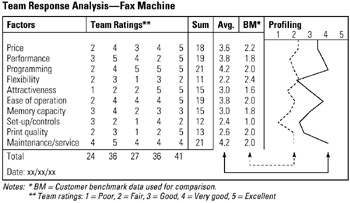Tool 165: Response Matrix Analysis
| AKA | Survey Profiling |
| Classification | Data Collecting (DC) |
Tool description
The response matrix analysis is often used to summarize rating responses from customers or team members on product characteristics and service quality, or to select a particular alternative from among several. Profiling rating averages to compare against benchmark or other standards will show perception differences or performance gaps.
Typical application
-
To summarize and profile raters' responses.
-
To choose among many complex alternatives.
-
To verify customer satisfaction for products or services.
-
To identify gaps in perception or performance when comparing one set of ratings against another.
Problem-solving phase
| → | Select and define problem or opportunity |
| → | Identify and analyze causes or potential change |
| → | Develop and plan possible solutions or change |
| Implement and evaluate solution or change | |
| Measure and report solution or change results | |
| Recognize and reward team efforts |
Typically used by
| 1 | Research/statistics |
| Creativity/innovation | |
| Engineering | |
| Project management | |
| Manufacturing | |
| 2 | Marketing/sales |
| Administration/documentation | |
| Servicing/support | |
| 3 | Customer/quality metrics |
| Change management |
before
-
Questionnaires
-
Surveying
-
Interview Technique
-
Demographic Analysis
-
Focus Group
after
-
Hypothesis Testing (Chi-Square)
-
Solution Matrix
-
Different Point of View
-
Run-It-By
-
Descriptive Statistics
Notes and key points
-
Profiling of data is frequently used to compare against an industry average, benchmark data, customer satisfaction, or established organizational goal metrics.
-
Optional four- or five-point rating scales are used to rate factors:
4 = Excellent
5 = Excellent
3 = Good
4 = Very good
2 = Fair
3 = Good
1 = Poor
2 = Fair
1 = Poor
Step-by-step procedure
-
STEP 1 The team develops a listing of product or service factors to be rated and profiled (compared) against customer benchmark data.
-
STEP 2 The team facilitator explains the rating scale to be used and asks participants to rate each factor. See example Team Response Analysis—Fax Machine.
-
STEP 3 All ratings are recorded on a whiteboard and summarized. Averages are calculated for each factor.
-
STEP 4 Customer benchmark averages are added, and both sets of rating averages are profiled as shown in the example.
-
STEP 5 The matrix is verified for accuracy and dated.
Example of tool application

EAN: 2147483647
Pages: 326